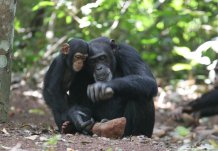Articles

Credit: Tetsuro Matsuzawa Primate Research Institute, Kyoto
Understanding the rich social lives of animals benefits international conservation efforts
An international group of researchers working on a wide range of species, from elephants and crows, to whales and chimpanzees, argues that animals’ cultural knowledge needs to be taken into consideration when planning international conservation efforts.
A paper published in leading journal Science (Tuesday 26 February) makes a compelling case that growing scientific evidence on social learning across a wide range of species, which can lead to unique animal cultures, is important for both conservation practice and conservation policy.
Insights into animal cultures can provide valuable information on ‘what’ groups of animals to conserve, and on ‘how’ best to conserve them. For example, understanding how grandmother killer whales pass on valuable information to their offspring, or why some groups of chimpanzees have a culture of cracking nutritious nuts with stone tools while others do not, can be key to evaluating conservation challenges for such species.
In many animal species, inexperienced young learn key survival skills by observing knowledgeable elders in their social group. This includes learning about how to communicate, how to forage efficiently, and where to migrate to when conditions become less hospitable.
For example, the transmission of knowledge on migration routes in whooping cranes, and bighorn sheep, can provide critical information for the success of future generations. Unlike genetic transmission, social knowledge can be passed on within generations, so knowledge about new food sources can be shared, potentially providing resilience in changing environments.
However, the authors report that social-learning processes can also result in the emergence of cultural sub-groups with distinctive behavioural profiles, potentially erecting social barriers, as observed for example in the distinctive vocal clans of sperm whales in the Eastern tropical Pacific. Such cultural segregation can have important conservation implications, especially when different groups have different foraging strategies and vary in their ability to cope with environmental change.
To protect ‘social capital’, some populations may be best delineated by their cultural behaviour, rather than using the traditional approach of assessing genetic diversity or the degree of geographic isolation. Moreover, for some species, protecting individuals that act as ‘repositories’ of social knowledge, such as experienced elephant matriarchs, may be just as important as conserving critical habitat.
“Beyond genes, knowledge is also an important currency for wildlife. As well as conserving genetic diversity, we must work towards maintaining cultural diversity within animal populations, as a reservoir for resilience and adaptation. This is an important reframing of our understanding of the natural world, which will necessitate changes in international wildlife law,” said the lead author of the paper, Philippa Brakes, from the University of Exeter, UK.
The Convention on the Conservation of Migratory Species of Wild Animals (CMS) – widely known as the ‘Bonn Convention’ – which operates under the umbrella of the United Nations Environment Programme (UNEP), has been a pioneer in this field, spearheading efforts to use scientific knowledge on animal cultures, to improve the conservation of migratory species.
The Science paper resulted from a seminal workshop in Parma, Italy, organised by the CMS, where experts pooled decades of expertise to devise concrete recommendations on how to improve conservation strategies. They highlighted that it is critical to catalogue the wide diversity of cultural behaviours within the animal kingdom, and to develop methods for identifying individuals who are the keepers of important social knowledge within their communities and require special protection.
Senior author of the paper, Professor Christian Rutz, from the University of St Andrews, UK, announced the publication of the group’s recommendations on Tuesday 26 February, at a workshop on animal cultures in Konstanz, Germany, co-organised by the Max Planck Institute for Ornithology Radolfzell and the National Geographic Society.
Rutz noted: “This is an incredibly important development. Decades of research on animal cultures are now being put to good use in conservation science and policy making, and we have a much better idea of what knowledge gaps still need filling.”
2020 is the final year of the United Nations Decade on Biodiversity. The papers’ authors emphasise that this work, at the interface between science and policy-making, is timely, as governments consider how best to conserve biodiversity in an ever-changing world. They urge that animal cultures must feature in these discussions, given their profound impact on the survival prospects of social units, and potentially entire populations.
“CMS is breaking new ground by looking at the issue of animal culture, social complexity, social learning and the role of individual and groups of individual animals as repositories of social knowledge. This pioneering work could have fundamental repercussions on how we approach conservation,” observed the late Dr Bradnee Chambers, former Executive Secretary of CMS. Dr Chambers was a strong advocate for this initiative, but sadly passed away earlier this year.
Dr Fernando Spina, Head of Science at ISPRA Italy and Chair of the CMS Scientific Council notes “This new frontier of animal culture and social complexity opens a fascinating and innovative perspective on how we consider animals; from single components of population models to individuals who offer specific contributions to the rest of the social group. When thinking of strategies to conserve migratory animals, which is the main mission of CMS at the global level, with individual animals visiting different countries along their annual cycle, cultural transmission of knowledge on how to fulfil their incredible migratory journeys is a new component environmental policies should fully take into account”.
This novel approach opens up opportunities for innovative ways of protecting and communicating about the natural world: understanding that other species have rich social lives and that they share important information with each other, provides an invaluable new perspective. With increasing habitat degradation around the globe, such insights may be vital for efficient animal conservation.
Date: 26 February 2019
